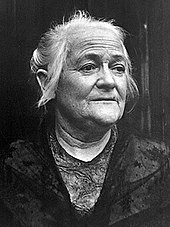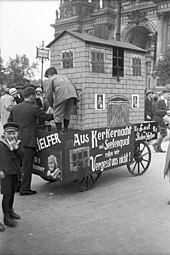Red Aid Germany
The Red Aid Germany ( RHD ) was a German political organization that the KPD was close to and was from 1924 to 1936.
Origin / history

In April 1921, as a result of the political repression after the March fighting, Red Aid Committees were set up at a conference of the KPD. In November 1921 a “Berlin Committee” was constituted as the “ Central Committee ”.
At the 4th World Congress of the Comintern in Moscow (October 5 to November 12, 1922) the formation of a " proletarian Red Cross " was decided, later International Red Aid (IRH, Russian МОПР / MOPR). On October 1, 1924, the " Red Aid Germany " (RHD) was founded as an organization close to the KPD . One of the founding members was the artist Heinrich Vogeler , who was also elected to the central board. Its first chairman was the later first and only President of the GDR, Wilhelm Pieck , who was previously the head of the “Legal Central Office of the Landtag and Reichstag faction of the KPD”. From 1925 Clara Zetkin took over the RHD management. After Julian Marchlewski's death in the same year, she also headed the International Red Aid.
Initially the organization was active with the campaign “ Red Aid for Victims of War and Labor ” for the International Association of Victims of War and Labor . However, the focus of the work was on supporting the imprisoned members of the Red Front Fighters Association , the SAP , KAP , trade unionists as well as non-party members and their relatives. For this purpose, legal advice centers were set up and publications critical of the judiciary were issued.
In 1923, the Red Aid declared March 18 ( Paris Commune ) to be the “International Day of Aid for Political Prisoners” and held it until it was banned by the National Socialists in 1933.
In March 1930, the RHD was involved in the establishment of a German section of the “International Legal Association” (IJV), which dealt with criminal, international, constitutional and labor law.
In 1933, the RHD was banned as part of the Reichstag Fire Ordinance. Lawyers and lawyers such as Hans Litten , Felix Halle and Alfred Apfel were arrested that same night. The Red Aid was disbanded by the Secret State Police by 1935/36 . Some members continued to work underground for some time, such as Lore Wolf , who, together with Johanna Kirchner , who belonged to the Workers' Welfare Association , which is closely related to the SPD , helped threatened people into exile across the Saar area . From 1933/34 Wilhelm Beuttel took over the management of the foreign organization of the RHD from Paris.
Outline and statistics
The local groups of the RHD consisted of company and residential district cells and were instructed by district boards who worked under a central board. An auditing commission was attached to the central board to monitor compliance with the statutes . Each local group had a legal protection commission , which should also involve local politicians. The Red Aid employed 60 to 80 people full-time. Among the more prominent members of the Red Aid was the lawyer and writer Felix Halle , who at times was also head of the legal central office of the KPD parliamentary group and parliamentary group. At annual RHD Reich Congresses, lawyers such as Kurt Rosenfeld and Hilde Benjamin gave lectures on criminal procedural law and other legal issues.
In 1933 the Red Aid had 530,000 members of which 119,000 belonged to the KPD and 15,000 to the SPD (1931 a total of 405,000); 55,600 were also IRH members.
From 1924 to March 1929, the RHD financed legal protection and support for 27,000 people and 16,000 prisoners in the amount of 4 million Reichsmarks . In 1932 there were 9,000 political prisoners , 20,000 family members and 50,000 leftists with preliminary investigations and trials. The RHD central board was linked to the KPD's legal central office and also worked with the Berlin IRH.

In the Worpswede artists' colony , Rote Hilfe had been running the Barkenhoff children's home since 1923 , after Heinrich Vogeler had given them his property for the low purchase price of 15,000 gold marks. From 1925 the MOPR children's home was added in Elgersburg . The homes were headed by a 46-member board of directors, including well-known people such as Albert Einstein and Thomas Mann .
The Red Aid of Germany was able to integrate a group of approx. 600 personalities from the democratic and left-wing intellectual spectrum. RHD campaigns, such as for the amnesty of political prisoners in 1928, for the freedom of art or against § 218 , were carried out by Albert Einstein , Kurt Tucholsky , Käthe Kollwitz , Heinrich Zille , Heinrich Mann , Erich Mühsam , Magnus Hirschfeld , Otto Dix , Max Liebermann , Erwin Piscator , Carl von Ossietzky , Heinrich Vogeler and others supported.
lawyers
Between 1924 and 1933 more than 300 lawyers worked for the Red Aid, around 50 of them for a longer period of time. The lawyer Hans Litten , who was active in the Red Aid and led spectacular political trials in the mid- 1920s , became famous. Towards the end of the republic, Litten received permanent personal protection from members of the RFB .
During the period in which it existed, around 330 lawyers worked for the Rote Hilfe on a case-by-case basis. Of these, 60% were of Jewish descent, which became significant when the law for the restoration of the civil service came into force on April 7, 1933 and many of them lost their licenses in German courts. ( World war participants were listed as " legal consultants " until the end of 1941.) Other lawyers covered the same law because of "communist activity". After losing your license, you often switched to corporate lawyers .
According to J.Schwarz, 22 lawyers were demonstrably taken to concentration camps . Some of them later belonged to the 55 lawyers who had emigrated. Jews who did not leave Germany until 1942 only survived the concentration camps in a few cases (e.g. Ernst Hegewisch and Gerhard Obuch ). Two lawyers fell victim to the Stalinist purges in the Soviet Union . Around 30 returned to Germany from exile, nine of them permanently to the GDR.
Central organ
The central organ of the Red Aid was Der Rote Helfer from 1926 to 1928 . From April 1927, Der Rote Helfer was published with a central page that could be removed as an agitation poster. Was superseded The Red helpers in 1929 by the illustrated newspaper Justice Tribunal . The illegal distribution of the newspaper can be proven from December 1933 to April 1936. In 1933 Wilhelm Pieck was the editor of the newspaper . Erich Hartmann was responsible for the entire content.
Processes and campaigns
- " Cheka trial " (February – April 1925) against KPD members (high treason)
- Trial series for the Hamburg uprising (January-May 1925)
- 1926 “ Out with Max Hoelz and all political prisoners ”, amnesty campaign
- 1929 Trials of the Berlin " Blutmai "
- 1931 Saxon " arms storage process " about the appropriation of a steel helmet warehouse on Reichswehr premises by leftists
- 1932 " X-ray street trial " for the death of an SA man
- 1932 " Felseneckeprocess " for the attack on an allotment garden colony close to the SPD
Defense in further processes for "freedom of art" and for SPD and Reichsbanner members
Start-ups
With reference to the historical Red Aid, the Red Aid eV became active in the Federal Republic of Germany in 1975 , until 1986 it officiated under the name Red Aid Germany . In Switzerland, too, there had been "Red Aid" since 1968 as a legal aid organization for the New Left.
Publications
- 1927: Torture Chamber America - Seven Years Sacco-Vanzetti (full text online; PDF; 11.2 MB)
literature
- Silke Makowski: "Help the prisoners in Hitler's dungeons". The Red Aid of Germany in the Illegality from 1933. (= series of publications of the Hans Litten Archive on the history of the Red Aid. Volume 1). Published by the Hans Litten Archive in Göttingen. Verlag Gegen den Strom, Munich 2016, ISBN 978-3-9809970-4-1 .
- Nikolaus Brauns : Get red help! History and activities of the proletarian aid organization for political prisoners in Germany (1919–1938). Pahl-Rugenstein, Bonn 2003, ISBN 3-89144-297-1 . (At the same time: Munich, University, dissertation: Red Aid Germany, from the Munich Women's Aid for Political Prisoners to the anti-fascist German People's Aid (1919–1938). )
- Siegfried Bresler among others: Der Barkenhoff, Children's Home of the Red Aid, 1923–1932. Worpsweder Verlag, Lilienthal 1991, ISBN 3-922516-91-2 .
- Sabine Hering , Kurt Schilde (ed.): Die Rote Hilfe. The history of the international communist “welfare organization” and its social activities in Germany (1921–1941). Leske + Budrich, Opladen 2003, ISBN 3-8100-3634-X .
- Heinz-Jürgen Schneider, Erika Schwarz, Josef Schwarz: The lawyers of the Red Aid Germany. Political defense attorney in the Weimar Republic. History and biographies. Pahl-Rugenstein, Bonn 2002, ISBN 3-89144-330-7 .
- Heinz Sommer: Clara Zetkin and the Red Aid. In: Yearbook for research on the history of the labor movement . Volume 7, No. 1, 2008, pp. 46-55.
- Hermann Weber : The change in German communism. The Stalinization of the KPD in the Weimar Republic. 2 volumes. European publishing company, Frankfurt am Main 1969.
Web links
Individual evidence
- ↑ Carola Tischler: "The courtrooms must be turned into tribunals against the class judges." The legal advice practice of Red Aid Germany . In: Sabine Hering, Kurt Schilde (ed.): Die Rote Hilfe. The history of the international communist "welfare organization" and its social activities in Germany . Leske + Budrich, Opladen 2003, ISBN 3-8100-3634-X .
- ^ Gerhard Kaiser: Home in an idyllic location. From the children's home of the Red Aid in Elgersburg to the Hotel "Am Wald". Berlin 2010.
- ↑ Nikolaus Brauns: Get Red Help! Bonn 2003, p. 192 f.
- ↑ Carola Tischler: "The courtrooms must be turned into tribunals against the class judges." In: Sabine Hering, Kurt Schilde (ed.): Die Rote Hilfe. The history of the international communist "welfare organization" and its social activities in Germany . Leske + Budrich, Opladen 2003, ISBN 3-8100-3634-X , p. 110 .
- ↑ studienkreis- resistance-1933-45.de
- ↑ Nikolaus Brauns: Get Red Help! Bonn 2003, p. 65.
- ↑ What do you need to know about the amnesty? Special supplement. In: Tribunal. No. 1, 1933. (digitized version)
- ↑ Hartmut Rübner: Red Aid in Switzerland. Constitutional conditions and forms of practice of a solidarity organization of the New Left (1968–1980). In: Yearbook for research on the history of the labor movement. Volume 9, No. 2, 2010, pp. 66-87.
- ↑ table of contents
- ↑ raeterepublik.de
